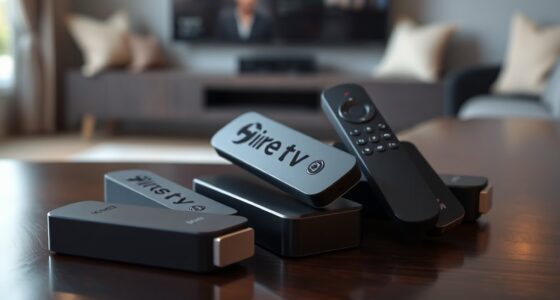To keep your home clutter-free without much fuss, focus on your most cluttered spaces first like the kitchen or bedroom. Use timers for quick cleaning bursts, and organize with a simple three-box method: keep, donate, throw away. Keep supplies nearby, break chores into short chunks, and make cleaning fun with music or podcasts. Regularly declutter high-traffic areas, prioritize major messes, and develop daily habits. Stay tuned to discover easy tips that make maintaining order effortless.
Key Takeaways
- Focus on high-traffic areas first, spending just 20-30 minutes to see quick, motivating results.
- Keep cleaning supplies nearby and organize tools to streamline chores and reduce effort.
- Use short, timed cleaning sessions with music or podcasts to make decluttering enjoyable and manageable.
- Implement a simple three-box system—Keep, Donate, Throw Away—to quickly sort and reduce clutter.
- Maintain tidiness with regular, quick routines and strategic storage, preventing buildup and making cleanup effortless.
Tackle Your Most Cluttered Spaces First
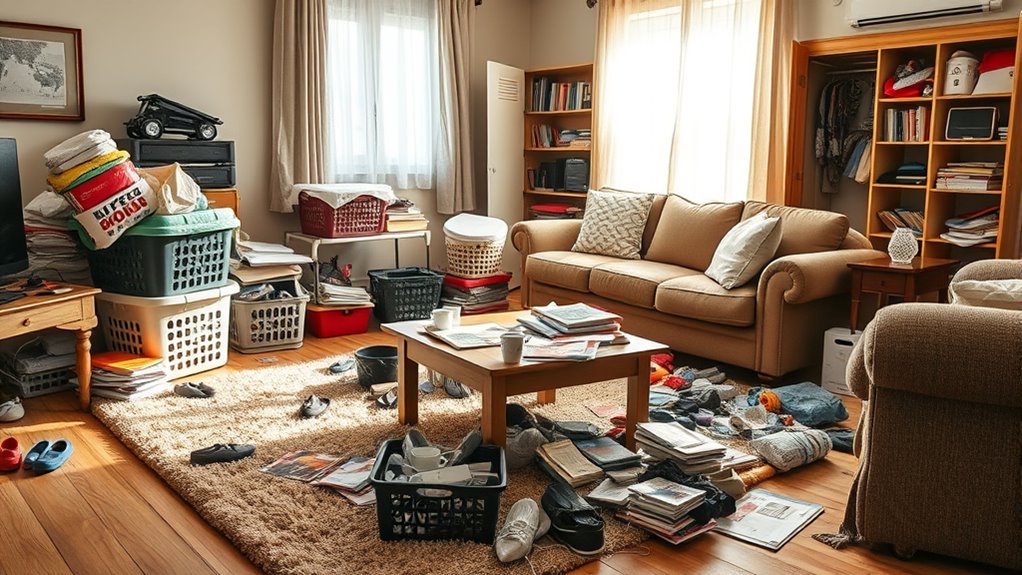
To make your decluttering efforts more effective, start by tackling your most cluttered spaces first, such as the bedroom, living room, or kitchen. Prioritizing these areas allows you to see quick, noticeable improvements, motivating you to keep going. Focus on one or two trouble spots at a time to prevent overwhelm and make managing the decluttering process easier. Spending just 20 minutes in these spaces can considerably reduce clutter and boost your sense of accomplishment. Clearing high-traffic or visible areas first also enhances motivation, encouraging you to continue organizing other parts of your home. Addressing your most cluttered spaces initially helps prevent the pileup from becoming unmanageable, streamlining your ongoing management and making the entire decluttering process more manageable. Incorporating vertical storage solutions can further maximize space and keep clutter at bay during your decluttering sessions, which is especially helpful when managing physical fatigue or limited energy. Additionally, adopting organized storage methods can improve accessibility and maintain your clutter-free environment over time.
Use Timers to Jumpstart Your Cleaning Sessions
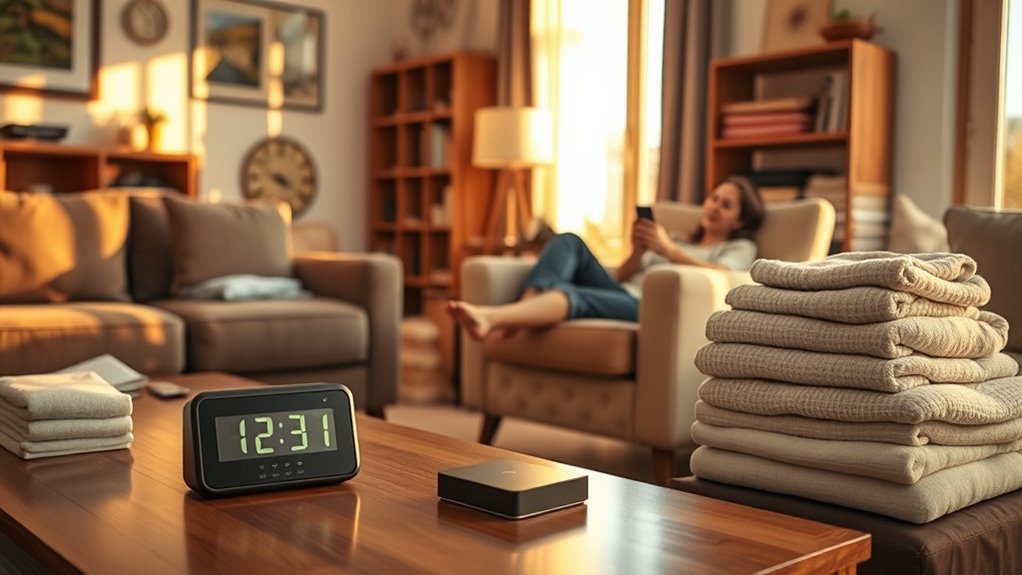
Setting a timer for just 10 minutes can be a powerful way to jumpstart your cleaning sessions. Timers create a sense of urgency, making tasks feel less overwhelming and more manageable. By focusing on short bursts of effort, you’ll boost your productivity and reduce the tendency to procrastinate. Using timers helps break your cleaning routine into achievable chunks, keeping you motivated with each quick win. You can customize timers to suit your schedule, dedicating specific periods for different chores throughout the day. Celebrating these small successes encourages positive reinforcement and builds momentum. Additionally, setting timers can help you better understand security zone info, such as how to allocate resources or time efficiently for home safety improvements. Regular use of timed sessions can also lead to better exfoliation, helping your skin look smoother and more radiant over time. Incorporating data-driven strategies can further optimize your cleaning approach for even better results. Moreover, applying these techniques can increase your awareness of your clutter hotspots, making it easier to target problem areas effectively. Over time, these timed sessions become a natural part of your routine, making clutter cleanup less intimidating and easier to sustain. Short, timed efforts deliver big results with minimal effort.
Organize With a Simple Three-Box System
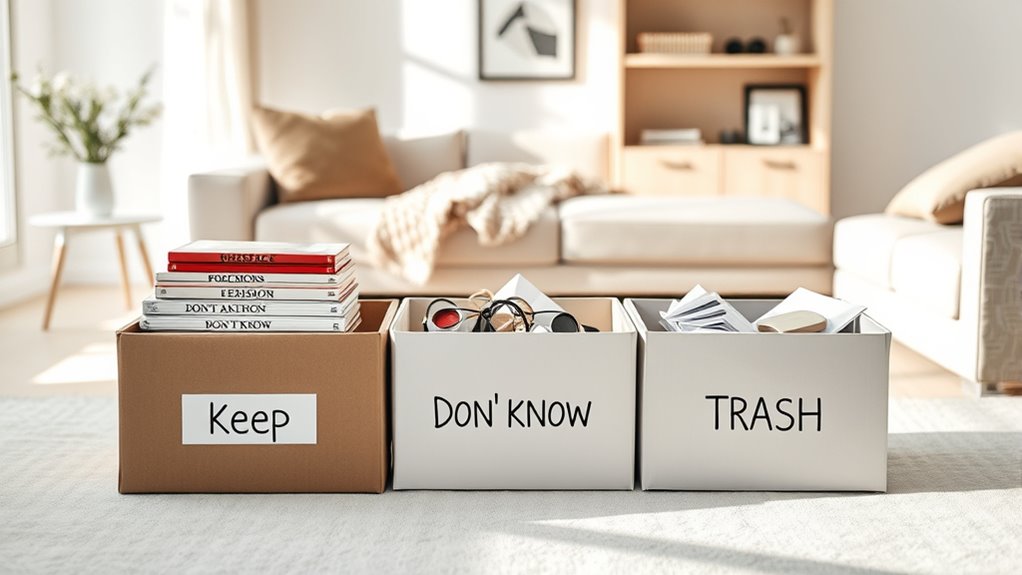
Using a three-box system makes decluttering quicker and less overwhelming. As you sort, label boxes as “Keep,” “Donate,” and “Throw Away,” and make decisions on the spot. Regularly acting on these boxes helps reduce clutter and keeps your space organized. Additionally, understanding the purpose of each category can improve your decision-making process and make your decluttering sessions more efficient clutter reduction. Incorporating a routine for reviewing and processing these boxes can further enhance your organizational habits and ensure your space stays tidy over time. Moreover, applying data-driven marketing strategies to your decluttering process—such as tracking which items are frequently discarded—can help optimize your routine for better results. Utilizing storage solutions like labeled containers or smart planters can also facilitate better organization and easy access to your belongings.
Declutter Efficiently
Organizing your belongings becomes more manageable when you adopt a simple three-box system. This method streamlines decluttering by helping you quickly sort items into “Keep,” “Donate,” and “Throw Away” boxes. As you go through your belongings, make immediate decisions, which boosts efficiency and reduces decision fatigue. Sorting items this way encourages mindful organizing, prompting you to evaluate each item’s importance rather than mindlessly holding onto clutter. Embracing minimalism becomes easier because you focus only on what truly adds value to your space. Regularly donating usable items not only clears your home but also benefits others. Incorporating software quality assurance principles into your decluttering process can help you develop better organization habits and maintain long-term results. Additionally, incorporating organic and natural juices into your routine can also motivate you to maintain a healthy, clutter-free lifestyle. Practicing mindful decision-making during this process ensures you stay focused on your decluttering goals. Understanding the importance of sound healing science and its benefits can inspire you to create a calming environment that encourages relaxation and clarity. This straightforward approach keeps decluttering simple, making it easier to maintain an organized, clutter-free environment without feeling overwhelmed.
Sort Items Strategically
Implementing a strategic approach to sorting your belongings makes decluttering more effective and less overwhelming. Using three boxes labeled “keep,” “donate,” and “throw away” simplifies decision-making and speeds up organization. As you go, sort items directly into these boxes, reducing decision fatigue and preventing clutter buildup. This method helps you see what’s unnecessary, freeing space and cutting cleaning time. To visualize, think of this system like a simple chart:
| Item Type | Keep (Useful) | Donate (Still Good) | Throw Away (Broken) |
|---|---|---|---|
| Clothes | ✔️ | ✔️ | |
| Books | ✔️ | ||
| Toys | ✔️ | ✔️ | |
| Old Electronics | ✔️ | ||
| Kitchen Items | ✔️ |
Regularly applying this system supports long-term organization and a clutter-free home. Incorporating mindfulness techniques during the process can help you stay focused and reduce emotional attachment to items. Additionally, choosing durable storage solutions can improve the longevity of your organized space and prevent future clutter. Being aware of data privacy challenges in digital organization tools can help protect your personal information during the decluttering process. Moreover, observing celebrity lifestyle insights can inspire creative ways to design your own space and stay motivated.
Furthermore, understanding astrological influences on personality traits can sometimes provide insight into what items hold sentimental value or significance for you.
Keep Cleaning Supplies Close to Where You Need Them
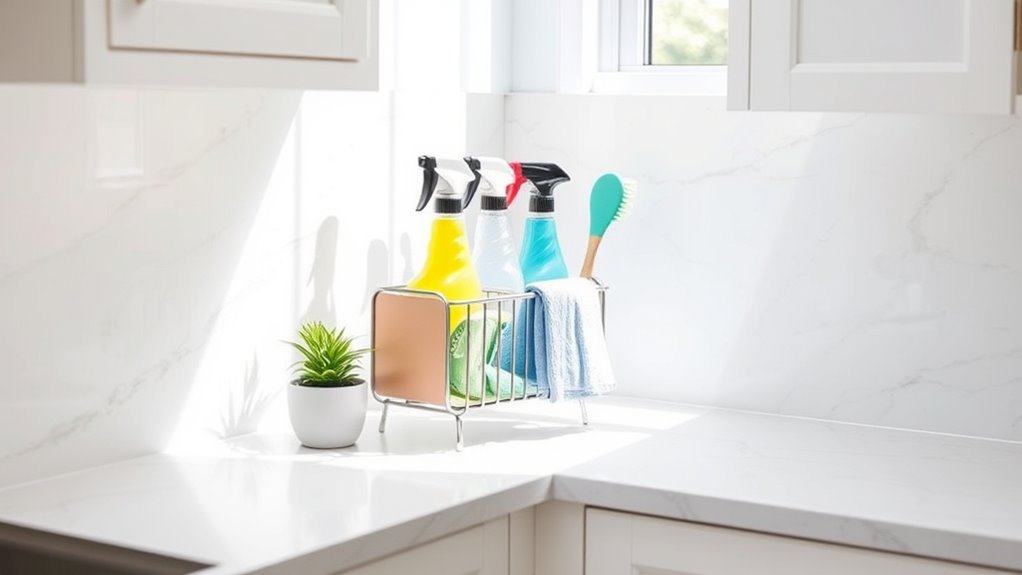
Keeping cleaning supplies close to where you need them makes your chores more efficient and less frustrating. When your supplies are organized in accessible spots, you save time and effort, making cleaning feel less like a burden. Store bathroom cleaners in the bathroom, and keep disinfectants or glass cleaners in key areas for quick access. Place dustpans, brooms, and mops near their respective zones to minimize retrieval time. Having frequently used products within arm’s reach encourages regular cleaning and prevents excuses. This strategic organization reduces clutter and makes your entire cleaning process smoother. Additionally, choosing modern fixtures can improve the overall functionality of your space, making cleaning easier and more effective. By keeping supplies handy and well-placed, you boost efficiency and maintain a tidy home effortlessly. It’s a simple step that turns cleaning into a quick, hassle-free task.
Break Tasks Into Short, Manageable Chunks
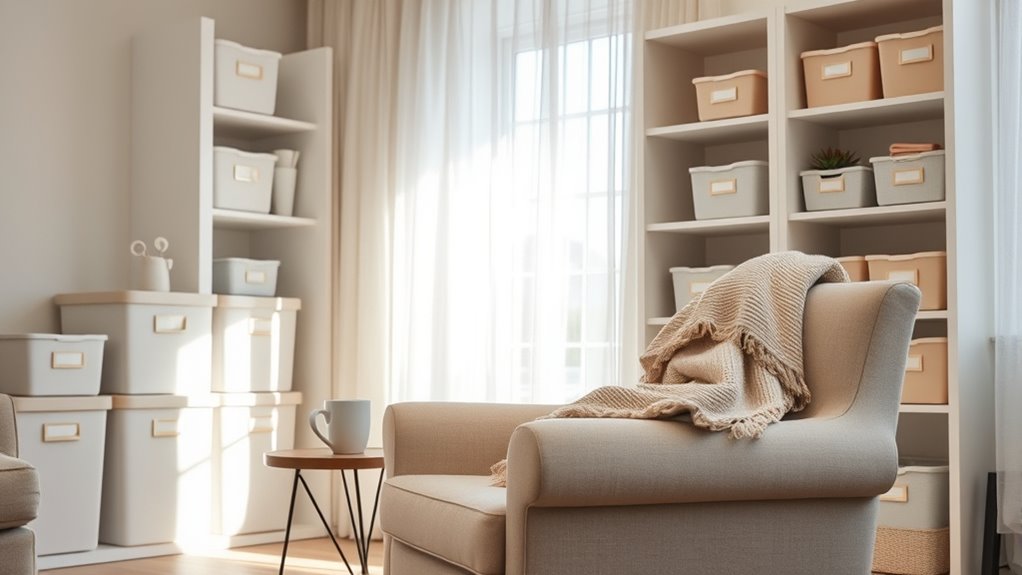
Breaking your cleaning tasks into short, 10-15 minute sessions makes the process feel less overwhelming and more doable. By focusing on small daily tasks or using quick time blocks, you’ll see steady progress without feeling drained. Setting a timer can boost your efficiency and keep chores manageable, even on busy days.
Focus on Daily Tasks
Focusing on small, manageable tasks each day makes clutter cleanup feel less intimidating and more achievable. By tackling daily tasks, you prevent clutter from piling up and reduce the time needed for quick cleaning sessions. Incorporate a routine of short, focused chores—like tidying a counter or organizing a drawer—so cleaning becomes a regular habit rather than a daunting project. Dividing chores into 5-10 minute segments keeps tasks manageable, making it easier to stay consistent. These quick, targeted efforts not only keep clutter under control but also build momentum toward a more organized home. Over time, this routine prevents messes from becoming overwhelming, making clutter-free living simpler and more sustainable with minimal effort.
Use Short Time Blocks
To make clutter cleanup feel less overwhelming, it’s effective to divide tasks into short, focused time blocks of 10-15 minutes. Using short time blocks helps you stick to cleaning routines without burnout. These manageable intervals keep your focus sharp and prevent procrastination by setting clear, achievable goals for each session. Decluttering becomes less intimidating when you see daily progress, even in small steps. Plus, breaking chores into chunks allows you to multitask, like listening to music or a podcast, making cleaning more enjoyable. Research shows that working in brief, concentrated sessions boosts motivation and makes maintaining regular routines easier. Over time, these short bursts add up, transforming your cluttered space into a tidy home without long, exhausting cleaning marathons.
Automate Routine Chores to Save Time
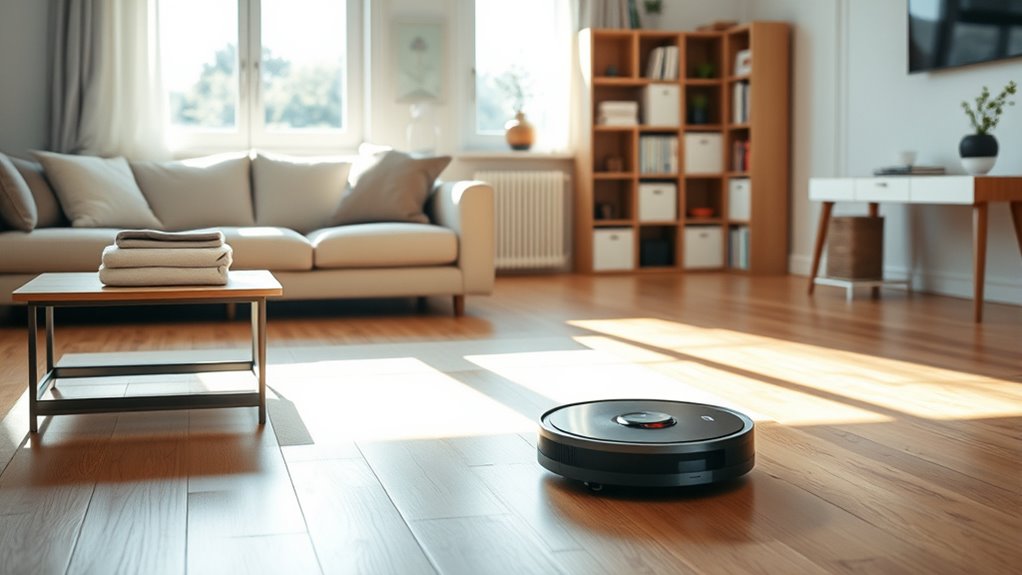
Automating routine chores can substantially reduce the time and effort required to keep your home clean. By automating chores, like laundry and dishwashing, you set up scheduled cycles that run automatically, ensuring consistent cleanliness without manual effort. Using smart home devices, such as robotic cleaners, keeps floors tidy daily with minimal oversight. Incorporate decluttering habits, like returning items immediately or using designated baskets, to prevent clutter buildup and make cleaning easier. Setting up reminders via smartphone apps helps you stick to a regular cleaning schedule without relying on memory. Installing sensor-activated fixtures, like touchless faucets and soap dispensers, reduces touch points and keeps surfaces cleaner effortlessly. These automated strategies free up your time and keep your home clutter-free with less hassle.
Make Cleaning More Enjoyable With Music or Podcasts

Listening to music or podcasts while cleaning can transform chores into more enjoyable experiences. When you add your favorite tunes or engaging podcasts, cleaning becomes less tedious and more motivating. Studies show that audio entertainment helps time pass quickly, making your routine feel effortless. Up to 70% of people find that music and podcasts boost their mood and energy levels during housework. Incorporating entertainment during cleaning can improve your focus and efficiency by reducing boredom and distractions. It also turns housework into a relaxing activity, encouraging consistency and a positive attitude. Whether you’re dancing to music or listening to an interesting podcast, you’ll find cleaning feels less like a chore and more like an enjoyable part of your day.
Declutter Regularly to Keep Things Under Control

Adding music or podcasts to your cleaning routine makes chores more enjoyable, but maintaining a clutter-free home requires regular effort. Decluttering on a consistent schedule prevents clutter from building up and makes organizing easier. Set a weekly or bi-weekly routine to sort through your belongings, using the three-box method—keep, donate, throw away—to streamline decisions. Returning items to their designated spots after use is key to ongoing maintenance and avoiding unnecessary messes. Regularly decluttering small areas prevents overwhelming clutter, making your home easier to manage with minimal effort. Embracing minimalism and sticking to your routine keeps clutter levels low, so you spend less time cleaning and more time enjoying your space. Consistent effort is the secret to effortless clutter control.
Prioritize Major Areas Over Tiny Details
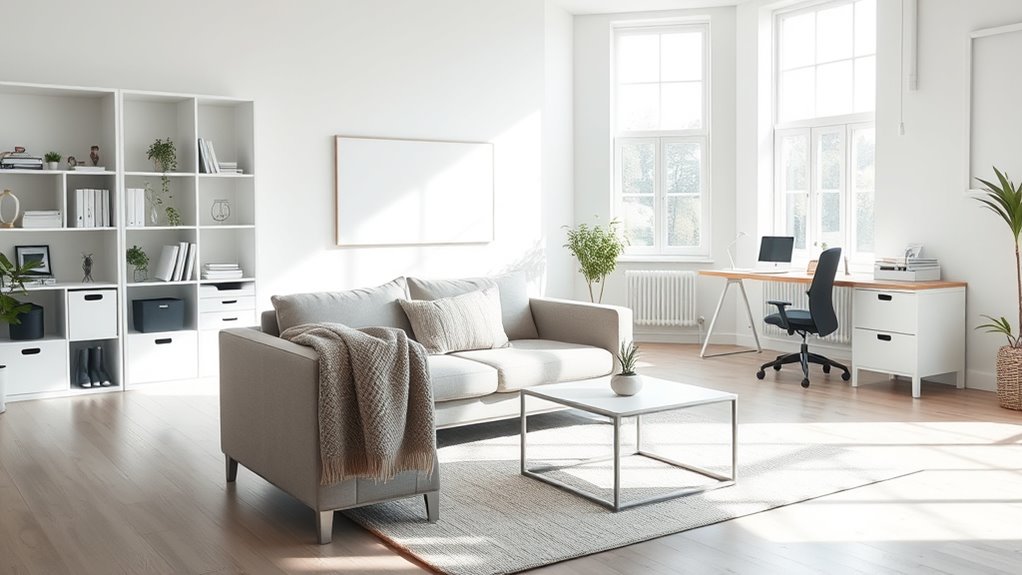
Focusing on major clutter hotspots like the living room, kitchen, and bedroom can dramatically improve your home’s overall appearance with less effort. These major areas have the biggest visual impact, so tackling them first makes your home look cleaner quickly. Addressing clutter hotspots prevents tiny details from becoming overwhelming and helps you stay motivated in your cleaning routine. By prioritizing large messes, you’re actively improving home organization without spending hours on minor spots. Concentrating on high-traffic, prominent spaces ensures your home looks tidy to guests, even if small clutter remains elsewhere. Spending just 20-30 minutes on these major areas each session creates a manageable routine that stops dirt and clutter from piling up, making your home feel consistently cleaner with minimal effort.
Develop a Consistent Daily Cleaning Habit
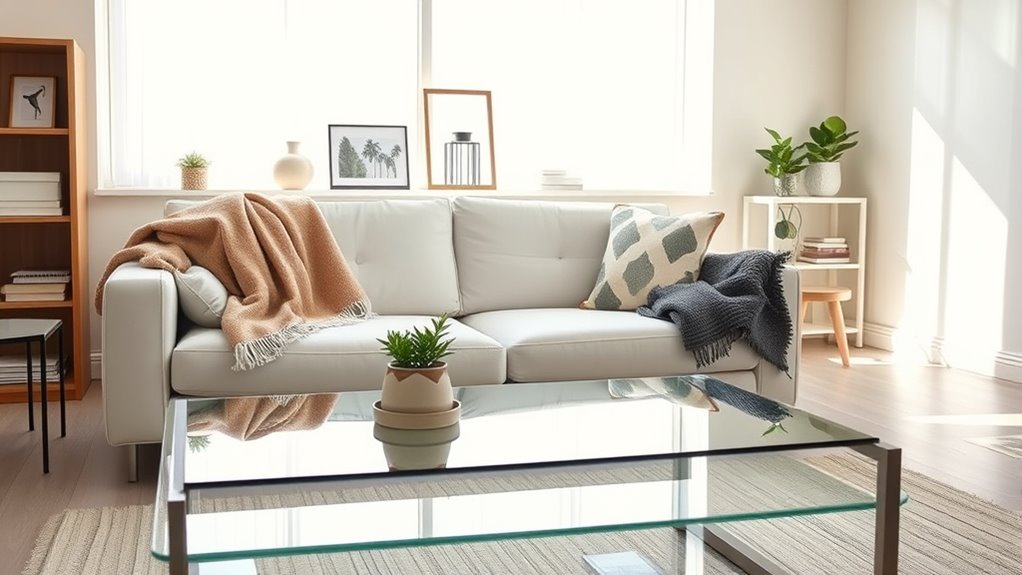
Developing a consistent daily cleaning habit is key to maintaining a clutter-free home. Spending just 10-15 minutes on daily cleaning tasks helps establish a routine that prevents clutter from piling up. Setting a specific time each day, like morning or evening, strengthens habit formation and makes cleaning feel automatic. Using a timer for focused sessions encourages commitment and keeps you on track. Incorporating a designated “stuff” drawer or space for miscellaneous items simplifies clutter management and cuts down decision fatigue. This consistent routine reduces the need for lengthy deep cleans and makes home upkeep less overwhelming. With daily effort, you’ll find clutter easier to control, and your home will stay tidier with minimal effort over time.
Frequently Asked Questions
Why Do Some People Hate Cleaning?
You might dislike cleaning because it feels boring or like a chore you can’t finish. Maybe the mess overwhelms you, making it seem unmanageable. Sensory discomfort from dirt or clutter can also cause emotional distress. If past experiences were frustrating or you struggle with organization, cleaning can seem futile. Plus, feelings of anxiety or procrastination might make you avoid it altogether, turning cleaning into a dreaded task.
How Do You Live in a Clutter Free Home?
Living in a clutter-free home isn’t about constant effort; it’s about smart habits. You declutter regularly, keep only what’s useful or joyful, and assign specific spots for everything. Daily quick tidies prevent buildup, and sorting items into keep, donate, or throw away keeps things manageable. By integrating these simple routines, you create a peaceful space where clutter doesn’t stand a chance, making home life easier and more enjoyable.
How to Clean When You Really Don’t Want To?
When you really don’t want to clean, set a tiny timer for 5-10 minutes and focus on just one small area, like a countertop or sink. Play your favorite music or podcast to make it more enjoyable. Break tasks into tiny steps, like wiping one shelf or folding a few clothes. Remember, even a little effort now prevents bigger messes later, making future chores easier and less overwhelming for you.
How Do People Keep Their House so Clean?
You keep your house clean by dedicating just 10-15 minutes daily to quick tidying and surface cleaning. Use designated drawers and storage to organize clutter immediately, preventing buildup. Focus on high-traffic areas and keep supplies easily accessible for prompt cleaning. Set timers or listen to music while you work to make it enjoyable. Breaking tasks into manageable steps and maintaining a routine helps you stay consistent effortlessly.
Conclusion
By tackling your cluttered spaces one step at a time, you’ll turn your home into a sanctuary rather than a stress trap. Think of it as chipping away at a giant iceberg—small efforts make a big difference. Keep things simple, stay consistent, and don’t forget to enjoy the process with your favorite tunes or podcasts. Before you know it, your home will feel lighter and brighter, a gust of fresh air in your busy life.


